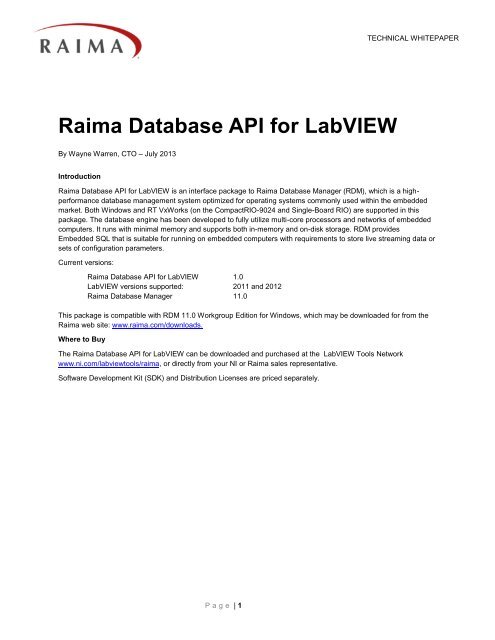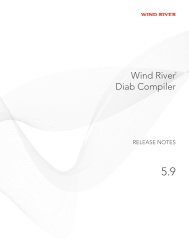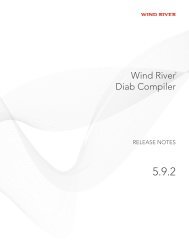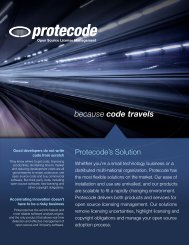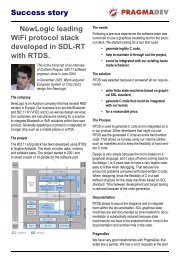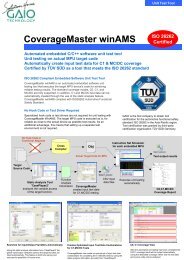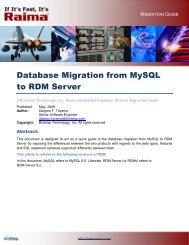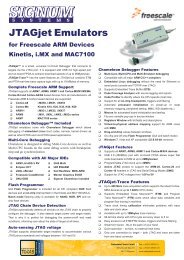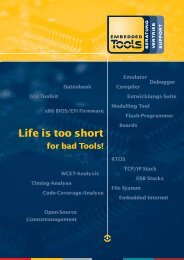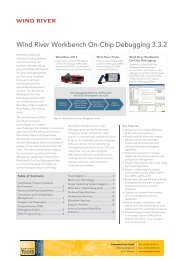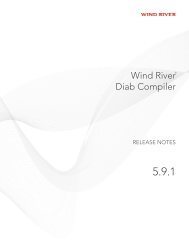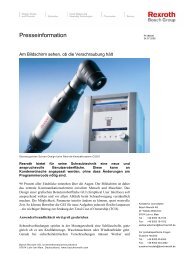RDM 11.0 Technical Overview Whitepaper - Raima
RDM 11.0 Technical Overview Whitepaper - Raima
RDM 11.0 Technical Overview Whitepaper - Raima
You also want an ePaper? Increase the reach of your titles
YUMPU automatically turns print PDFs into web optimized ePapers that Google loves.
TECHNICAL WHITEPAPER<strong>Raima</strong> Database API for LabVIEWBy Wayne Warren, CTO – July 2013Introduction<strong>Raima</strong> Database API for LabVIEW is an interface package to <strong>Raima</strong> Database Manager (<strong>RDM</strong>), which is a highperformancedatabase management system optimized for operating systems commonly used within the embeddedmarket. Both Windows and RT VxWorks (on the CompactRIO-9024 and Single-Board RIO) are supported in thispackage. The database engine has been developed to fully utilize multi-core processors and networks of embeddedcomputers. It runs with minimal memory and supports both in-memory and on-disk storage. <strong>RDM</strong> providesEmbedded SQL that is suitable for running on embedded computers with requirements to store live streaming data orsets of configuration parameters.Current versions:<strong>Raima</strong> Database API for LabVIEW 1.0LabVIEW versions supported: 2011 and 2012<strong>Raima</strong> Database Manager <strong>11.0</strong>This package is compatible with <strong>RDM</strong> <strong>11.0</strong> Workgroup Edition for Windows, which may be downloaded for from the<strong>Raima</strong> web site: www.raima.com/downloads.Where to BuyThe <strong>Raima</strong> Database API for LabVIEW can be downloaded and purchased at the LabVIEW Tools Networkwww.ni.com/labviewtools/raima, or directly from your NI or <strong>Raima</strong> sales representative.Software Development Kit (SDK) and Distribution Licenses are priced separately.P a g e | 1
TECHNICAL WHITEPAPERCONTENTS1. Operational <strong>Overview</strong> ............................................................................................................................................ 32. Programming with the Database API .................................................................................................................... 32.1 Allocate Handles .................................................................................................................................................. 32.2 Create or Open a Database ................................................................................................................................. 42.3 Populate and Read a Database ........................................................................................................................... 52.4 Close a Database ................................................................................................................................................ 52.5 Share/Use a Database ........................................................................................................................................ 6Sharing a Database ............................................................................................................................................... 6Using a Database .................................................................................................................................................. 62.6 Connecting Real-time Programs to Windows Databases .................................................................................... 72.7 Arrays .................................................................................................................................................................. 83. <strong>Technical</strong> Details ................................................................................................................................................... 83.1 Windows .............................................................................................................................................................. 83.2 CompactRIO VxWorks ......................................................................................................................................... 93.3 The Complete API ............................................................................................................................................. 113.4 Error Codes ....................................................................................................................................................... 154. Additional Resources .......................................................................................................................................... 234.1 Support .............................................................................................................................................................. 234.2 LabVIEW Page .................................................................................................................................................. 23P a g e | 2
TECHNICAL WHITEPAPER1. OPERATIONAL OVERVIEWThe Database API consists of a set of primitive functions that are generally consistent with the ODBC standard.Databases are defined and manipulated in the SQL language. Each Database API function calls a Native C functionthrough the Call Library Function Node VI. The Native C function will then call the <strong>RDM</strong> API (the same functionsavailable directly to the C programmer using <strong>RDM</strong> <strong>11.0</strong> Workgroup Edition).The basic call stack is shown in Figure 1:Figure 1: Basic Call StackThe <strong>RDM</strong> ODBC API contains all of the database manipulation logic. The basic call stack is the same whetherdeployed in Windows or CompactRIO VxWorks.Section 4 will discuss how to implement database sharing, but the basic concept of sharing is shown below:Figure 2: Sharing/Using a Database2. PROGRAMMING WITH THE DATABASE APIThose familiar with the ODBC API will recognize the steps needed to work with databases. The following sectionsshow the basic operations.2.1 Allocate HandlesThe following figure shows preparation work necessary for the rest of the steps. The Connection and/or StatementHandles are required inputs for the rest of the functions.P a g e | 3
TECHNICAL WHITEPAPERFigure 3: Allocate HandlesFrom left to right, Figure 3 goes through the following steps:Allocate a Connection Handle (SQL_HANDLE_DBC).Set the location for storage of the database (SQL_ATTR_<strong>RDM</strong>_TFSINIT_DOCROOT). This example showshow to specify the “LabVIEW Data” directory. If this is not specified, the current directory of the executingprogram will be used.Connect.Allocate a Statement Handle (SQL_HANDLE_STMT). One connection can support many statements, but itis typical to use one.2.2 Create or Open a DatabaseCreating a database in ODBC can be accomplished by executing a minimum of two SQL statements. In the followingfigure, two Execute SQL Statement Now (SQLExecDirect) functions are used to do just that:Figure 4: Create a New DatabaseHere is a description of the steps:Execute “create database” statement. Database named HelloWorld.Execute “create table” statement. Table is named HelloTable containing one character string column namedhello.Commit the transaction. It is during the commit where the database is physically created on the storagemedia.P a g e | 4
TECHNICAL WHITEPAPERNote that when a database should always be created (rather than opening an existing database), it is best to deletethe database before creating it.Figure 5: Dropping a Database2.3 Populate and Read a DatabaseInsert and commit two rows:Figure 6: Populate a DatabaseDatabase population frequently occurs in loops, but this simple example performs two inserts:Insert the value “Hello World!” into the string column in the table, creating one row.Insert the value “Hi Back!” into the string column in the table.Commit the two rows to the database.2.4 Close a DatabaseThe clean way to close a database is to make sure of the following:All transactions have been committed or aborted.All Statement Handles have been freed.The Connection Handle has been freed.In this example, the transaction we committed after inserting the two rows, so there is nothing to complete in regardsto transactions.Figure 7: Clean Up / Close DatabaseP a g e | 5
TECHNICAL WHITEPAPER2.5 Share/Use a DatabaseStandard connection to the <strong>Raima</strong> API is standalone. To allow a database to be shared, you must properly set someconnection attributes.Sharing a DatabaseA database that is used by one program can be made sharable to other programs by identifying the Server as “self” inthe “Connect to a Data Source.vi”.Figure 8: Sharing a DatabaseOnce the “self” connection is established and a database open, this program must continue running in order for otherprograms to use the database. In the loop shown below, other work may be done on the database, but a soon as theloop terminates, the shared database will also be unavailable:Figure 9: Keeping a Database Alive for UsersA rule about sharing is that a database must be “used” by another program running on the same architecture, e.g.cRIO-9024 to cRIO-9024 or Windows to Windows. Note below that another method exists to make cRIO compatiblewith Windows, but it requires an SDK for <strong>RDM</strong> <strong>11.0</strong> on Windows.Using a DatabaseThis example assumes that two (or more) different computers are being used, with one LabVIEW program running oneach. More advanced methods will allow multiple programs to run and share databases in the Windows environment,but that will not be covered here.Once a database has been shared by another program, you need to know the name or IP address of the computeron which that program is running. Then, before the “Connect to a Data Source.vi” you need to set theSQL_ATTR_<strong>RDM</strong>_TFSINIT_TYPE to 1 and identify the other computer with the SQL_ATTR_<strong>RDM</strong>_TFS_NAMEattribute:P a g e | 6
TECHNICAL WHITEPAPERFigure 10: Using a Shared DatabaseNote that the SQL_ATTR_<strong>RDM</strong>_TFSINIT_DOCROOT is not necessary when using a database because thedatabase location is established by the sharing program. Note also that it may be set in this program without negativeconsequences.2.6 Connecting Real-time Programs to Windows DatabasesThere is yet-another connection method that has the following advantage/disadvantage:Advantage – Database compatibility between RT cRIO and Windows.Disadvantage – Database cannot be stored on the cRIO.On Windows, the <strong>RDM</strong> SDK contains a program named <strong>RDM</strong>SQLSERVER.EXE. When this program is running on aWindows computer within a specified document root, it can be accessed by LabVIEW programs running on RTsystems concurrently with any database program running on Windows (LabVIEW or otherwise). This is because thecommunication method between the <strong>RDM</strong> runtime system on cRIO is heterogeneous.On Windows, run the utility, specifying the document root:Figure 11: Starting <strong>RDM</strong>SQLSERVER on WindowsThen from cRIO, name the Server input in “Connect to Data Source.vi”. The name is the computer’s domain name orIP address.Figure 12: Connect to <strong>RDM</strong>SQLSERVER from cRIOP a g e | 7
TECHNICAL WHITEPAPER2.7 ArraysArrays of values are supported in the Database API, but they follow different rules.1. Regardless of the basic data type, the column is defined as “long varbinary”.2. A “Prepare” is required (cannot input array data with the “Execute SQL Statement Now” function).3. The array is input after the “Execute SQL Statement” function using the “Set a Parameter … Array” function.The default length is the length of the array. You may enter a specific length.When there are other non-array columns in the row, they must be input before the “Execute SQL Statement” function.See below for the general flow:Figure 13: SQL DDL for Array StorageFigure 14: Storing Scalar and Array Columns3. TECHNICAL DETAILSThis secton is meant as a quick look under the hood:3.1 WindowsWhen installed, <strong>Raima</strong> Database API for LabVIEW will have a complete SDK for Windows, allowing programs to berun on Windows or cRIO-9024. You may not need to know much of the following information, but here it is just incase.Toolkit VIs: \vi.lib\addons\_<strong>Raima</strong> Inc\<strong>Raima</strong> Database API for LabVIEW\Example VIs: \examples\<strong>Raima</strong> Inc\<strong>Raima</strong> Database API for LabVIEW\P a g e | 8
TECHNICAL WHITEPAPERError Codes (<strong>Raima</strong>-Database API-errors.txt): \user.lib\errors\Help file (<strong>Raima</strong>-Database API for LabVIEW.chm): \help\RT Images: \RT Images\<strong>Raima</strong>DatabaseAPI\1.0\Several Windows DLLs are required. The DLL named <strong>RDM</strong>-Native.DLL is the native interface module specificallycreated for the LabVIEW VIs to use. The remainder of the DLLs are part of the <strong>RDM</strong> <strong>11.0</strong> product. All of the WindowsDLLs are stored in the \licensed\Private\ directory.3.2 CompactRIO VxWorksAll of the binary code needed for RT operation on the cRIO-9024 is contained in a file named <strong>RDM</strong>-Native.out. It isoriginally stored in the directory identified above, in the Windows installation.To make sure the RT module is installed, follow this procedure:1. Open MAX and locate your target under Remote Systems, expand the tree and right-click on Software, andselect Add/Remove Software to launch the wizard:2. In the LabVIEW Real-Time Software Wizard, select Custom Software Installation and click Next (agree tothe dialog/warning):P a g e | 9
TECHNICAL WHITEPAPER3. You will now see the <strong>Raima</strong> module under the list of available features:4. Select "Install the feature" and press Next>> twice. MAX will put your RT system into "install mode", tellingyou when your Real-Time target has been updated successfully.P a g e | 10
TECHNICAL WHITEPAPERHere are some more advanced technical details:A serial connection from Windows to cRIO-9024 can be useful during real-time testing. On the device, besure that the switch “CONSOLE OUT” is turned on (left side). Between the two computers, connect a NullModem serial cable. From Windows, use a remote connection program like Putty, select Serial connectionwith 9600 baud. On the console, you will see <strong>RDM</strong> print its document root every time it is activated. Use ^Hfor backspace. Also, the commands “pwd”, “cd” and “ls” behave as expected.The directory onto which LabVIEW places its add-on object code modules is /c/ni-rt/system. You may useFTP to place <strong>RDM</strong>-Native.out in this location if necessary (for example, if you obtain an update fromwww.raima.com/ni, FTP will allow you to overwrite the original file.If it appears that your configuration of VxWorks on cRIO does not have the right support modules installedfor <strong>RDM</strong> to run, you may find out extra information from the console:o cd “ni-rt/system”o ld < <strong>RDM</strong>-Native.outIf there are any symbols missing or duplicated, they will be listed when you attempt to load the <strong>RDM</strong> library.In addition to other methods, you can use the console to reboot the cRIO:o rebootData, by default, is placed into the “LabVIEW Data” directory, located in /c/ni-rt/LabVIEW Data. You canview the database(s) contained there as follows:o cd “ni-rt/LabVIEW Data”o ls3.3 The Complete APIThe following table shows the functions organized as they appear in the Functions Palette.Palette Function Name PrototypeMainAllocate a HandleMainConnect to Data SourceMainEnd a TransactionMainExtended TransactionOperationMainFree a HandleSQLClose a CursorP a g e | 11
TECHNICAL WHITEPAPERPalette Function Name PrototypeSQLCount of Affected RowsSQLExecute a SQLStatement NowSQLExecute a SQLStatementSQLFetch Data and MoveCursorSQLFetch the Next RowSQLFree a StatementSQLGet a Cursor NameSQLPrepare a StatementSQLRequest More ResultsSQLSet a Cursor NameDataGet Rowset DataPolymorphic8-bit Integer ArrayDataGet Rowset DataPolymorphic8-bit IntegerDataGet Rowset DataPolymorphic16-bit Integer ArrayDataGet Rowset DataPolymorphic16-bit IntegerP a g e | 12
TECHNICAL WHITEPAPERPalette Function Name PrototypeDataGet Rowset DataPolymorphic32-bit Integer ArrayDataGet Rowset DataPolymorphic32-bit IntegerDataGet Rowset DataPolymorphic64-bit Integer ArrayDataGet Rowset DataPolymorphic64-bit IntegerDataGet Rowset DataPolymorphicStringDataGet Rowset DataPolymorphicDouble ArrayDataGet Rowset DataPolymorphicDoubleDataGet Rowset DataPolymorphicFloat ArrayDataGet Rowset DataPolymorphicFloatDataSet a Parameter ValuePolymorphic8-bit Integer ArrayDataSet a Parameter ValuePolymorphic8-bit IntegerDataSet a Parameter ValuePolymorphic16-bit Integer ArrayP a g e | 13
TECHNICAL WHITEPAPERPalette Function Name PrototypeDataSet a Parameter ValuePolymorphic16-bit IntegerDataSet a Parameter ValuePolymorphic32-bit Integer ArrayDataSet a Parameter ValuePolymorphic32-bit IntegerDataSet a Parameter ValuePolymorphic64-bit Integer ArrayDataSet a Parameter ValuePolymorphic64-bit IntegerDataSet a Parameter ValuePolymorphicDouble ArrayDataSet a Parameter ValuePolymorphicDoubleDataSet a Parameter ValuePolymorphicFloat ArrayDataSet a Parameter ValuePolymorphicFloatDataSet a Parameter ValuePolymorphicStringAttributesColumn AttributesP a g e | 14
TECHNICAL WHITEPAPERPalette Function Name PrototypeAttributesSet ConnectionAttributesAttributesSet ConnectionAttributesMetadataDescribe a ColumnMetadataDescribe a ColumnExtendedMetadataNumber of ResultColumnsMetadataRequest Metadata forColumnsMetadataRequest Metadata forPrimary KeysMetadataRequest Metadata forTables3.4 Error CodesA large number of error codes may potentially be returned by the <strong>RDM</strong> SQL module. The following table provides theerror code, the SQL State (which may be used in a keyword search on the web for more detailed information), andthe <strong>RDM</strong>-specific short description.Code SQL State Description402160 1004 data truncation402161 RX003 psp subsystem initialization failure402162 42000 syntax errorP a g e | 15
TECHNICAL WHITEPAPERCode SQL State Description402163 42000 no CREATE DATABASE has been issued402164 RX004 unable to open <strong>RDM</strong> core-level DDL file402165 42000 column is not declared in referenced table402166 42000 matching primary key does not exist in referenced table402167 42000 foreign/primary key columns do not match402168 42000 foreign key column is not declared in table402169 42S21 column already declared in table402170 42S21 table with the same name already been created402171 3C000 duplicate cursor name402172 42000 specified domain name not found402173 42S02 table not found402174 22008 date/time value overflow402175 42000 key column not found402176 RX005 unable to open file402177 HY013 memory management error402178 42000 bad formatting specification402179 22005 bad binary literal specification402180 22005 bad literal specification402181 22001 string literal too long402182 42000 database does not exist402183 42000 unable to open catalog file402184 42000 unable to initialize database402185 RX006 file I/O error402186 8003 connection is not open402187 HY009 invalid argument value402188 HY009 invalid use of null pointer402189 HY010 must free all connection handles first402190 HY090 invalid string or buffer length402191 7006 data type attribute violationP a g e | 16
TECHNICAL WHITEPAPERCode SQL State Description402192 7009 invalid descriptor index (column number)402193 7009 invalid descriptor index (parameter number)402194 HY010 function sequence error402195 25000 transaction is active402196 25000 transaction not active402197 RX007 <strong>RDM</strong> runtime error402198 8000 must call before connect402199 42000 databases to be opened already specified402200 42000 database not open402201 21S01 insert value list does not match column list402202 21S02 select result columns do not match column list402203 42S22 column not found402204 7002 insufficient number of parameters specified402205 42000 must specify value for column402206 42000 table name not in FROM clause402207 42S22 column name not found402208 HY106 fetch type out of range402209 HY107 row value out of range402210 HY109 invalid cursor position402211 24000 invalid cursor state402212 24000 current/cursor's statement is not SELECT402213 22003 numeric value out of range402214 22003 significant data lost due to truncation402215 23000 referential integrity error402216 HY010 connection not closed402217 HY001 driver memory allocation error402218 HY024 invalid attribute value402219 HY092 invalid attribute/option identifier402220 01S01 error in rowP a g e | 17
TECHNICAL WHITEPAPERCode SQL State Description402221 01S02 option value changed to default402222 42000 data type mismatch402223 22019 invalid escape character402224 RX008 invalid statement state402225 42000 aggregate functions not allowed in WHERE402226 22012 division by zero402227 42000 escape clause syntax error402228 42000 prior prepared DDL statement not executed402229 42000 invalid use of parameter marker402230 42000 duplicate stored procedure name402231 RX009 stored procedure file not found402232 21000 invalid number of arguments specified402233 42000 joined columns must match exactly402234 42000 too many columns declared in foreign/primary key402235 42000 no access path between outer joined tables402236 8002 connection already in use402237 42000 UDF/UDP/XTF already registered402238 42000 all standard tables must be declared before first virtual table402239 42000 data type not allowed for virtual table columns402240 RX010 virtual table function error402241 42000 reference to unregistered UDF/UDP/Virtual Table402242 RX011 user-defined function error402243 RX012 no result from user-defined function402244 RX013 UDFLOADTABLE entry definition error402245 21000 invalid function argument type402246 21000 incorrect number of function arguments402247 42000 SET NULL cannot be specified when nulls are not allowed402248 42000 invalid column reference in INSERT expression402249 42000 duplicate primary/unique key valueP a g e | 18
TECHNICAL WHITEPAPERCode SQL State Description402250 42000 SET NULL not allowed with ON UPDATE402251 42000 ON UPDATE CASCADE not allowed when foreign key column is used in a key402252 42000 changes to referenced restricted primary/unique key not allowed402253 42000 duplicate join column402254 42000 no matching join columns402255 42000 invalid order/group by column reference402256 21000 incorrect number of function arguments402257 42000 invalid number of specified function arguments402258 RX014 operation is read only402259 RX015 invalid statement type402260 42000 only one DISTINCT aggregate function is allowed402261 HY008 statement execution canceled by user402262 42000 aggregate functions not allowed in GROUP BY402263 7006 invalid C data type402264 7006 invalid SQL data type402265 7005 prepared statement is not a valid cursor402266 7009 invalid descriptor index402267 25S01 transaction state unknown402268 HY007 associated statement is not prepared402269 HY011 invalid operation at this time402270 HY012 invalid transaction operation code402271 HY016 cannot modify an implementation row descriptor402272 HY017 invalid use of implicit descriptor handle402273 HY021 inconsistent descriptor information402274 HY091 invalid descriptor field identifier402275 HY094 invalid scale value402276 HY105 invalid parameter type402277 HYT00 timeout expired402278 HYC00 driver not capableP a g e | 19
TECHNICAL WHITEPAPERCode SQL State Description402279 HYC00 optional feature not implemented402280 HYC00 invalid conversion402281 22002 indicator variable required but not supplied402282 IM001 function not supported402283 42000 invalid TFS location spec - should be: @hostname:port402284 RX016 import/export error402285 RX017 TFS system error402286 RX018 JNI/ADO.Net system error402287 RX019 RPC communication error402288 25000 read-only transaction is active402289 25000 unlock not allowed in a transaction402290 25000 table is not locked402291 25000 operation not allowed due to active read locks402292 42000 DDL requires that no databases be open402293 25000 multiple database transactions are not allowed402294 42000 invalid date format402295 42000 invalid date separator402296 42000 invalid db open mode402297 RX020 operation requires exclusive database access402298 42000 SELECT or column is not updateable402299 42000 default values not allowed on long var{char|binary} columns402300 42000 blobs cannot be referenced in expressions in deferred mode402301 RX021 data-at-exec params only allowed with INSERT VALUES/UPDATE402302 RX022 data-at-exec params only allowed for blob (long var...) columns402303 RX023 data-at-exec param type not compatible with blob (long var...) column402304 HY020 attempt to concatenate a null value402305 HY095 function type out of range402306 HY097 column type out of range402307 HY098 scope out of rangeP a g e | 20
TECHNICAL WHITEPAPERCode SQL State Description402308 HY099 nullable type out of range402309 HY100 Uniqueness option type out of range402310 HY101 Accuracy option type out of range402311 HY004 invalid SQL data type402312 42000 circular tables cannot be referenced402313 RX024 unable to connect to TFS402314 42000 must specify '(length)' with variable size columns402315 42000 cannot specify both MAXPGS and MAXROWS options402316 42000 cannot delete rows from a circular table402317 42000 maxrows can only be specified with CREATE CIRCULAR TABLE402318 42000 cannot refer to blob column in WHERE in deferred reading mode402319 42000 database already exists402320 RX025 TFS already initialized402321 RX026 illegal locking mode402322 42000 no columns have been updated402323 42000 operation not allowed when autocommit is enabled402324 42000 positioned UPDATE/DELETE table does not match cursor's402325 42000 positioned UPDATE/DELETE not allowed in stored procedure402326 25000 Inconsistent read-only transaction commit/rollback/end call402327 42000 duplicate table reference in FROM clause402328 42000 another database is already open in different mode402329 42000 cannot call an aggregate function within an aggregate function402330 42000 char/wchar type is required402331 8001 unable to connect402332 25000 cursor's read locks freed by intervening commit/rollback402333 RX027 invalid transaction id402334 42000 db union open invalid when other database is open402335 42000 database unavailable due to exclusive access rules402336 42000 database has already been openedP a g e | 21
TECHNICAL WHITEPAPERCode SQL State Description402337 42000 database is opened for read only402338 42000 sorting on a blob column is not allowed402339 42000 blob columns cannot be referenced in a SELECT with GROUP BY402340 HY009 invalid argument type402341 42000 statements from different connections402342 42000 unable to process outer join specification402343 42000 invalid access--use rsqlShowPlan/SQLShowPlan function402344 42000 query() cannot be used in SELECT result column402345 42000 virtual table access restricted to INSERT or SELECT402346 42000 out of space in virtual table402347 42000 blob columns cannot be used in WHERE clause of a SELECT with ORDER BY402348 42000 invalid data type mapping402349 7009 named parameter not found402350 RX999 unused error code402351 RX029 database is currently in use402352 RX030 database is being used by other task(s)/user(s)402353 42000 function cannot be called from a UDF402354 42000 database not opened - use read-only mode to open core databases402355 RX031 incompatible catalog version402356 42000 ON condition only allows equi-join predicates402357 42000 result column must have aggregate function call402358 8001 the specified DOCROOT is already in use402359 42000 no registered function interface for virtual table402360 42000 database does not contain any virtual tables402361 34000 invalid cursor name402362 0T000 target table does not match cursor specification402363 42000 FOR UPDATE column not in SELECT list402364 RX032 stored procedure has an invalid version402365 42000 distinct can only be specified with aggregate UDFP a g e | 22
TECHNICAL WHITEPAPERCode SQL State Description402366 42000 database does not contain any tables402367 42000 core DDL keyword cannot be used in SQL DDL402368 42000 invalid import/export file type402369 42S21 duplicate table aliases402370 RX028 yet to be implemented feature402371 42000 system error40281 42000 invalid connection or statement handle4. ADDITIONAL RESOURCES4.1 SupportFor technical support, please contact <strong>Raima</strong> directly at www.raima.com.Benefits of support include:Support provided through <strong>Raima</strong> Monday through Friday 8am PT to 4pm PTOne Named CallerUnlimited Number of IncidentsResponse - Next Business DayOnline Product DocumentationOnline <strong>Technical</strong> ForumOnline Incident Tracking & UpdatesCustomer Determined Incident Severity LevelIncident Escalation ProcessCritical Patch NotificationPatch DistributionUpdates (i.e. 1.1 to 1.2 – change to right of decimal point)National Instruments does not provide technical support for third-party add-ons for LabVIEW.Please check out www.raima.com/ni for product information and any updates to <strong>RDM</strong> Native or the <strong>RDM</strong> DLLs.4.2 LabVIEW PageNational Instruments provides tips, techniques and FAQ's at www.ni.com/labviewtools/raima. This page will have allof the informational resources specially designed for LabVIEW programmers.P a g e | 23
TECHNICAL WHITEPAPERWant to know more?Please call us to discuss your database needs or email us at info@raima.com. You may also visit our website for thelatest news, product downloads and documentation:www.raima.comHeadquarter: 720 Third Avenue Suite 1100, Seattle, WA 98104, USA T: +1 206 748 5300Europe: Stubbings House, Henley Road, Maidenhead, UK SL6 6QLT: +44 1628 826 800Copyright <strong>Raima</strong> Inc., 2013P a g e | 24


